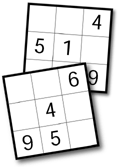 |
Sudoku Solver Updated 29 Nov 2025for Android Read the update |
SudokuWiki.org
Strategies for Popular Number Puzzles
|
| Logged out | Please report any bugs and feedback welcome |
|
|||||||||||||||||||||||||||||||||||||||||||||||||||||||||||||||||||||||||||||||||||||||||||||||||||||||||||||||||||||||||||||||||||||||||||||||||||||||||||||
| Enter clues or solutions |
|
||||||||||||||||||||||||||||||||||||||||||||||||||||||||||||||||||||||||||||||||||||||||||||||||||||||||||||||||||||||||||||||||||||||||||||||||||||||||||||
|
|
|
|
||||||||||||||||||||||||||||||||||||||||||||||||||||||||||||||||||||||||||||||||||||||||||||||||||||||||||||||||||||||||||||||||||||||||||||||||||||||||||
Welcome to my Sudoku X Solver
Sudoku X is a great variant of normal Sudoku and this solver is an extension of my Sudoku Solver to help you discover the logical solutions for this puzzle. The difference is that in Sudoku X the two diagonals are known to contain the numbers 1 ro 9 uniquely. These extra constraints allow you the puzzle solver to dervice new conclusions about candidates to eliminate and find solutions to cells. You can look along the diagonals (marked with a darked X on th board) and make deductions. However, the extra constraints mean that the puzzle creator can leave less clues than normal sudoku.
For the easier Sudoku X puzzles you won't really find a necessary example of a deduction based on the diagonals although you will want to scan them in case you see an easy 'single'. For tough puzzles and above the diagonals must be checked. In this solver they are checked before rows, columns and boxes. All the normal rules and logical posibilities apply to Sudoku X with some exceptions. There are pitfalls, for example, with Unique Rectangles, which rely on a certain formations. I have documented these here. Please check this stratgy guide if you want to use the advanced strategies.
I am now working independently on puzzle creation.
All feedback, comments, arguments, bug reports and strategy ideas are welcome. There is a new FEEDBACK form with a column displaying comments and questions. Many thanks to all the people who have done so and helped improve this solver.
Version history here Original version 1.42 12th Jan 2008Now updated and expanded!
Many people have written to me to comment about multiple solutions for a given Sudoku. There are no logical tricks the solver can use to detect this other than not complete correctly. The only way to check this is to perform a brute force analysis which tests every possible legal placement of a number. Computers are good at this and we now have a new yellow button called "Solution Count". Try this on any Sudoku to check if it has a unique solution.
Strategy Overview
The six seven tests are the simplest and are required for any sudoku. After that you are allowed to choose which strategies the solver will use. Tick and untick the check boxes. For example, you may not want to use any strategies that rely on a unique solution. Uncheck test 15.
The order of these advanced strategies - and my inclusion of them in categories 'tough', 'diabolical' and 'evil' are my personal choice after close study and are roughly in order of complexity. While the logic is different for each, you should be aware that there is considerable overlap in their power to solve in certain situations.
All strategies in the list have links to documentation, but it's worth describing what the first tests do:
- Show Possibles: For each unknown square we eliminate all possibles where those numbers are known in each row, column and box. This may reveal a single candidate, in which case we have a solution for that cell.
- Test 1: If a possible number occurs once in a row, column, box or diagonal we can eliminate other candidates and make this the solution to the square.
- Test 2: In this test we check for 'naked' Pairs and Triples. For example, if we have two pairs, eg 3-4 and 3-4 in the same row, column or box, then both 3 and 4 must occupy those squares (in what ever order). 3 and 4 can then be eliminated from the rest of the row, column or box.
- Test 3: This test is for Hidden Pairs and Hidden Triples.
- Test 4: This test is for Naked Quads and Hidden Quads.
- Test 5: See Pointing Pairs and Triples for a full explanation. This test helps us eliminate numbers in rows and columns outside the box.
- Test 6: Box/Line Reduction.
We check the box against the rows and columns that intersect it for each number.

